If you are fed up with having succulents in regular green, you could consider growing orange succulents in your garden .
Orange succulents are eye-catching and they will add a sense of vibrant color to your garden. How wonderful would it be to add a succulent which has the hue of a sunset in your collection?
Someone may not like to have succulents in overly bright yellow ones, in that case, orange succulents could be very handy.
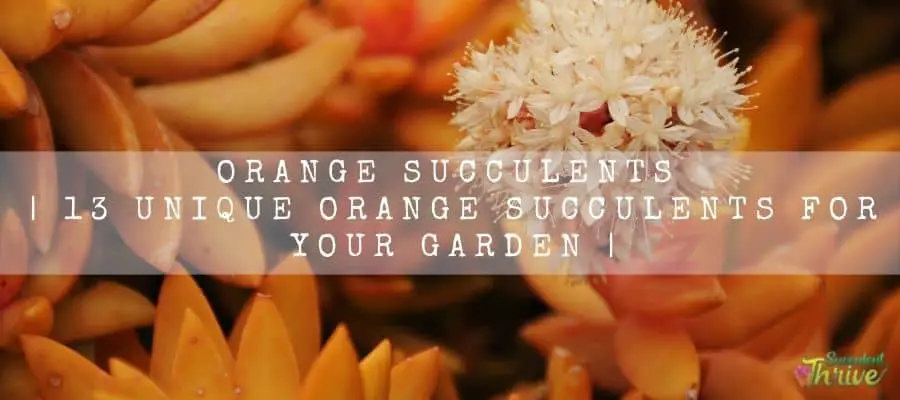
Orange succulents have the perfect brightness which anybody would love to have in their garden collection as they would add so much cheer to the whole set up where you have grown them.
It could be a landscape or even an interior space. Apart from that they would be very useful to add them in a combination where you have added succulents in various colors.
So, do you fancy having an orange succulents in your garden collection? If so, here you are at the write page as this article will surely help you to decide on the exact orange succulents you wish to have as we will be covering some common orange succulents in this article. So let us dig into it further.
Graptosedum ‘California Sunset’
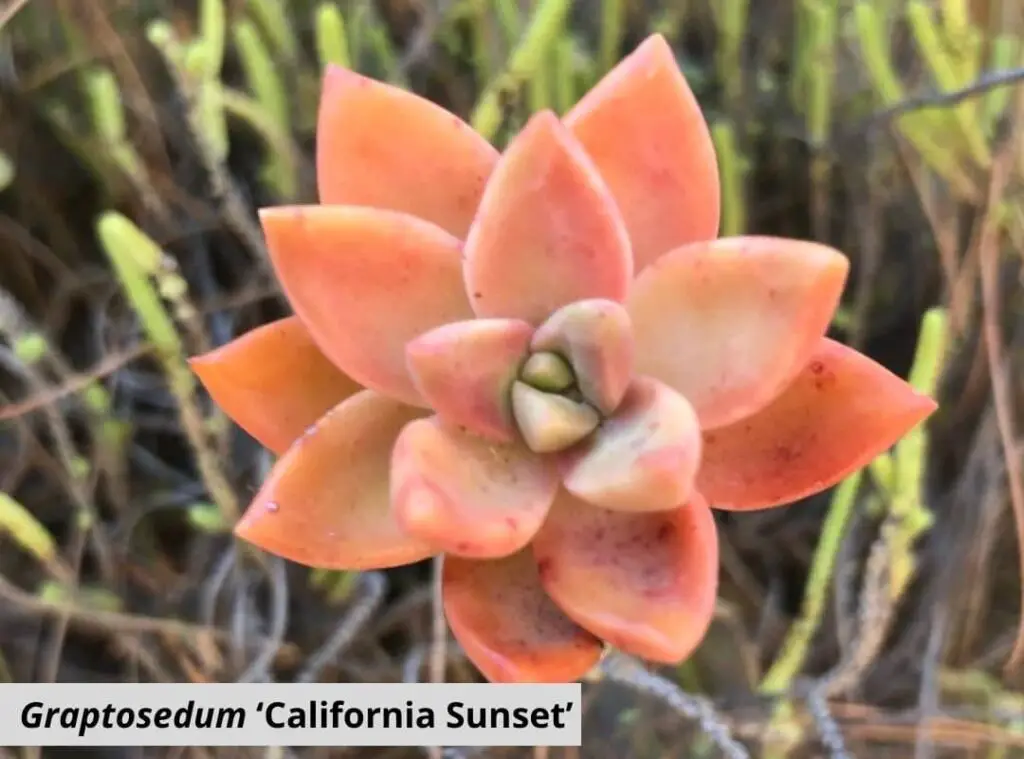
California sunset is a hybrid cross between Graptopetalum paraguayense and Sedum adolphi. You could spot their leaves in orange along with a slightly hue in pink.
Further they will form their new growth in gray green color. Later on, they will tend to develop the orange hue once they are exposed to the winter cool temperatures.
You could spot these plants forming in rosettes just like the Echeverias.
They would further grow with a leggy and a long structure. That is what makes this plant look distinctive in its looks.
Moreover, they would prefer to grow in USDA zones 10a-11b. 30 °F (−1.1 °C) to 50 °F (+10 °C). They tend to grow in clumps and usually will rise to 15 cm in height.
You could grow them indoors as well as outdoors. However, you need to protect them from winter weather conditions when you grow them outdoors.
Orange crassula rogersii
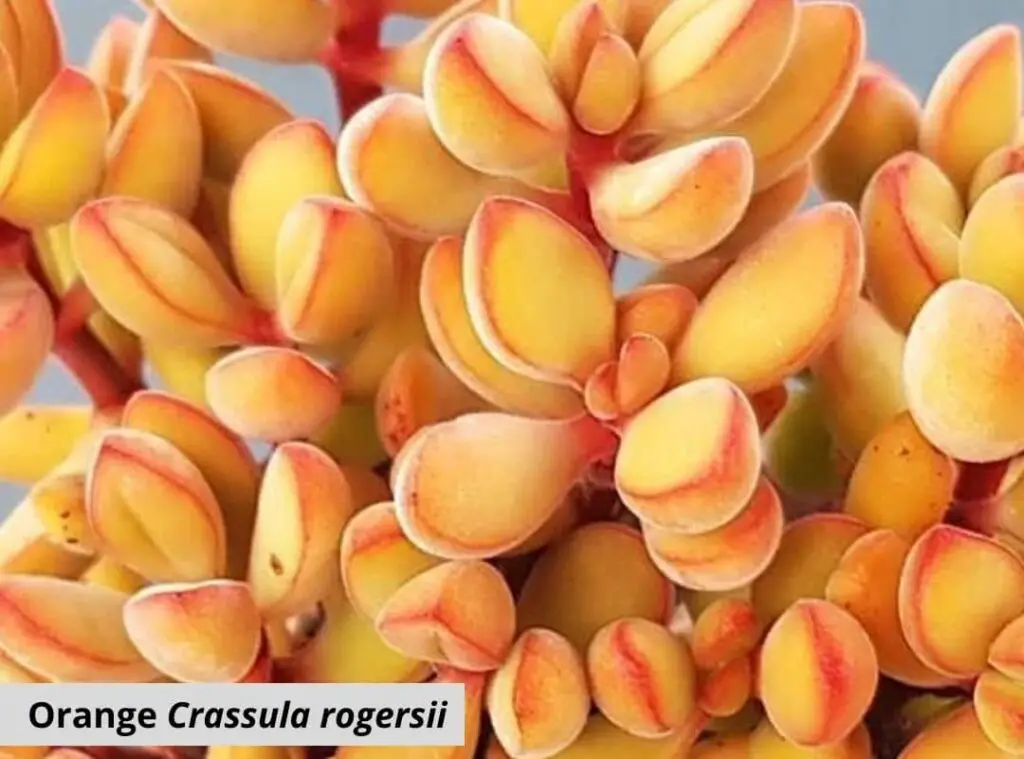
Orange Crassula rogersii plants are tall and tend to grow in bushey manor. They could be about 12 inches tall when they are fully matured.
Further they consist of droplet shaped leaves as well. Moreover, these plants would carry a velvety texture too.
They are native plants in South Africa. They are a versatile set of plants. Hence would perfectly fit in for both indoors and for outdoors as well. Moreover, they would prefer to grow in USDA 9b-10b.
Sedum adolphii ‘Golden Sedum’
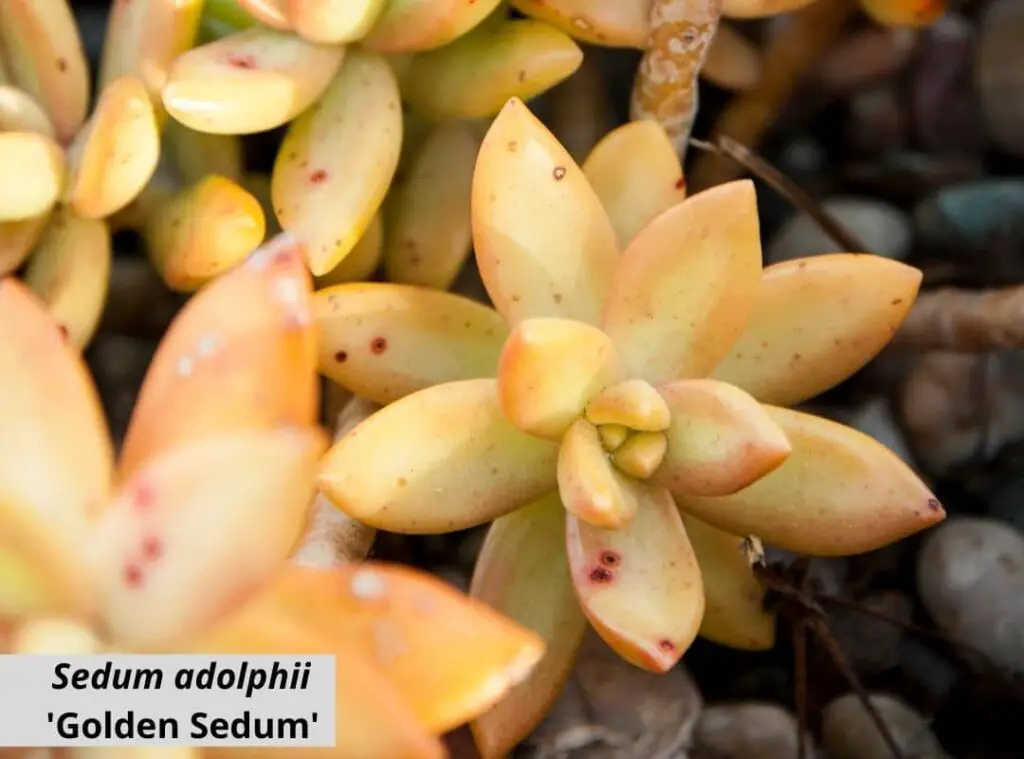
Golden Sedum plants usually grow in a trailing manner. Golden Desum form miniature rosettes and their leaves would resemble footballs.
They could be handy to use indoors and outdoors as well. You could either grow them as hanging potted plants or ground covers too.
They would usually be about 10 inches tall when they are fully mature.
When you expose them for more sunlight, those leaves tend to turn a vibrant orange color. You could expect them to flower in spring along with white flowers.
Golden Sedum plants are native in Mexico. USDA hardiness zones 8b-11 are their preferred growing zones.
Sedum nussbaumerianum ‘Coppertone Stonecrop’
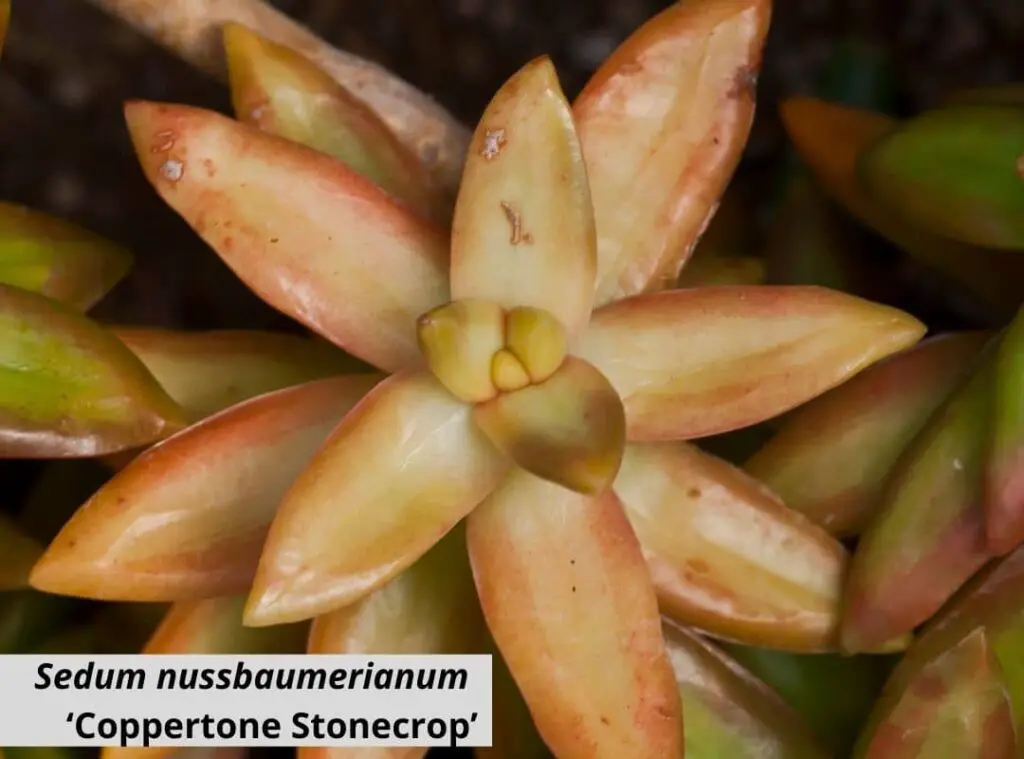
Sedum nussbaumerianum ‘Coppertone Stonecrop plants generally have bright orange or green colored leaves.
They would usually bloom with tiny white colored flowers in summer. Coppertone stonecrop plants are native plants in Mexico.
They could rise to 8 inches in height and 2-3 feet in width when they are fully matured.
These plants’ leaves are plump and long too. Just like with the other succulents, if you expose them for bright sunlight, they will become more vibrant in their colors along with shades of coppery orange.
You could grow them as ground cover outdoors and as houseplants indoors as well. Their preferred USDA hardiness zone is 9. They resemble stars in shape.
Echeveria ‘Orange Monroe’
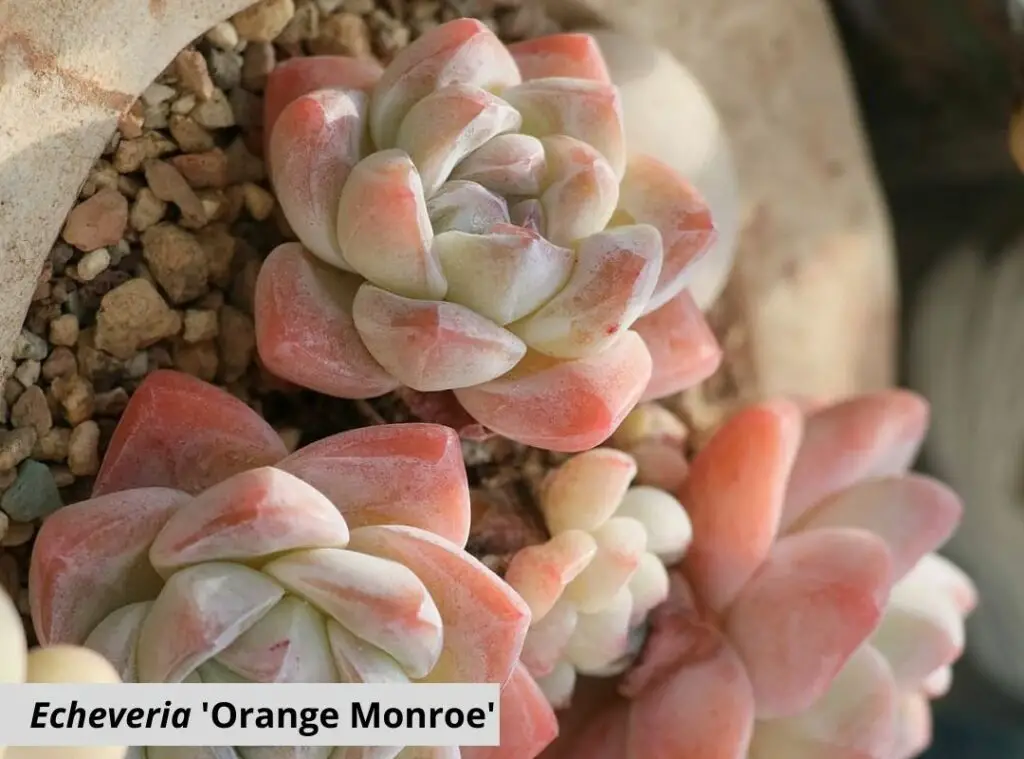
Echeveria Orange Monroe form in an attractive rosette type and their leaves would be carrying green and orange shades.
If you expose them to more sunlight, they will turn best in their orange color. Orange Monroe leaves form in rosette type and they would be about 6 inches in width.
If you live in frost climates you could consider growing them outdoors. If not, you may grow them indoors as well.
If the space you have to grow a succulent is very limited, you could consider growing an Orange Monroe. They are small and compact.
Their foliage color would be silver, blue in color. They are native plants in Canary Island, Morocco and in East Africa as well. Their preferred USDA hardiness zones are 9b-11b.
Echeveria ‘Sanyatwe’
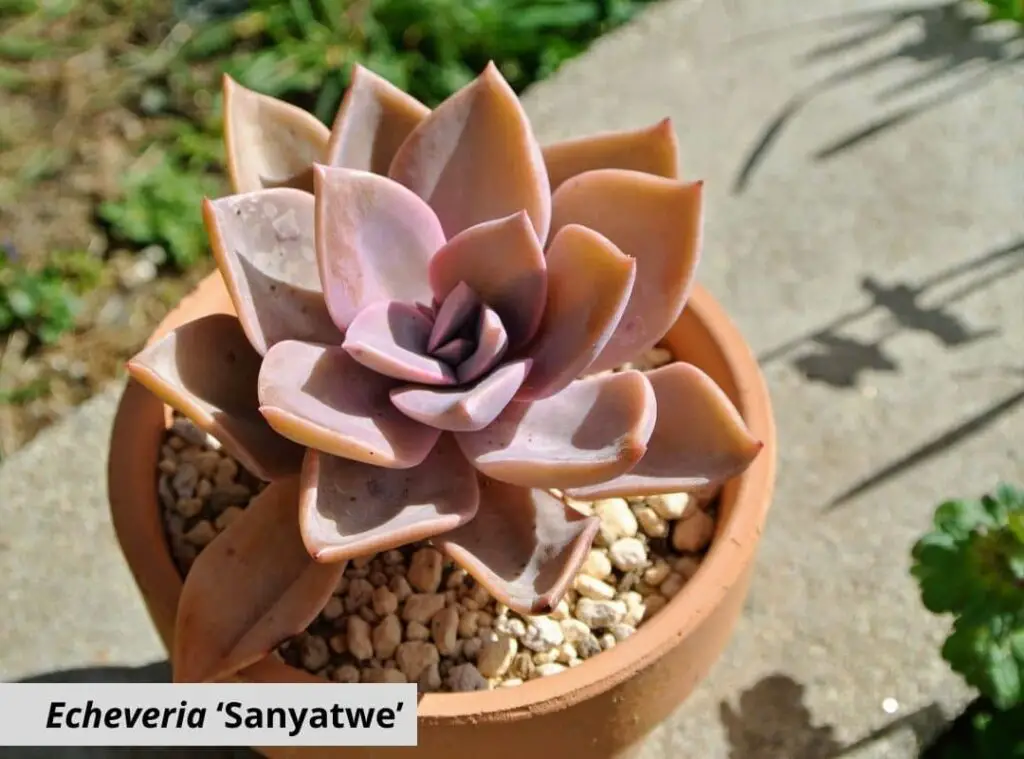
Echeveria ‘Sanyatwe’ are a tiny, yet attractive set of plants. They comprise chubby peachy, orange-colored leaves.
Those leaves form in rosette type and they would be six inches in width. On the other hand, this plant will be about 8 inches in height and 8 inches in width.
They would be quite handy if you wish to add a vibrant color to your garden. You need to be vigilant when handling these plants since they have fragile leaves.
This is a stunning plant since it could maintain its enchanting color throughout the year. Hence you may add them to your container garden or to your rock garden.
Echeverias are native plants in Mexico, central America and in South America as well. Further you may grow them as outdoors plants as well as indoor plants too.
Graptopetalum ‘mendozae’
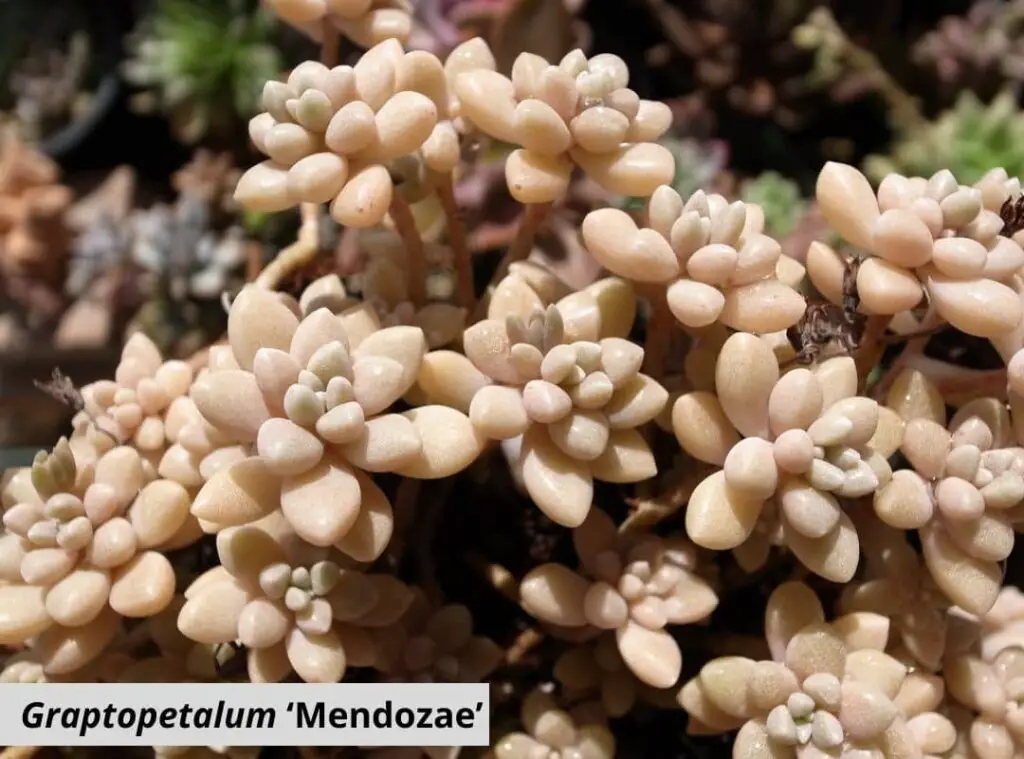
Graptopetalum mendozae are yet another stunning orange succulents. They would be about 15 cm (6 inches) in height once they are in their full maturity.
Graptopetalum mendozae are native plants in Mexico and in Arizona as well. They grow in rosette types and would prefer to grow in USDA hardiness zones 8a-10b. (10 degrees Fahrenheit).
Best is to grow them as outdoor plants if you live in aforesaid zones. Having said that, you could grow them as indoor plants as well. However, ensure that you provide the right growing conditions.
They would produce star shaped blooms during spring to late summer. They would be handy in using as rockery plants.
They have fleshy pale green colored leaves which tend to grow in rosette shape. Further their leaves would be round in shape. Graptopetalum mendozae leaves colors would turn dark during summer.
Graptoveria ‘Fred Ives’
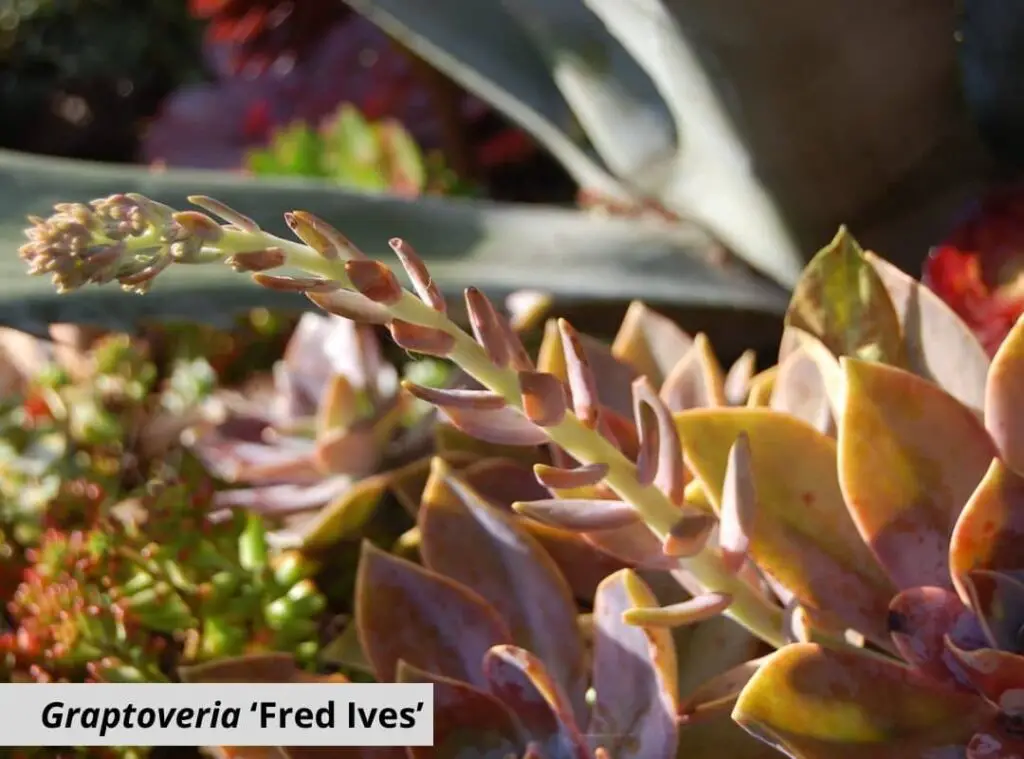
Fred Ives is a result of a cross formation of Graptopetalum paraguayense and Echeveria gibbiflora.
They would form leaves in distinctive orange, deep red and in bright green colors also. Fred ives plant leaves arranged in rosette type.
They could be about 12 inches in width. On the other hand, this whole plant will rise to 8 inches in height given that they get all right growing conditions.
You could expect them to flower with yellow flowers during summer. Fred Ives tends to grow in clumps. Apart from that, their leaves consist of bronze pointed tips too.
In terms of flowering, they would produce blooms in pale yellow colors. They would further consist of red orange centers too.
You could grow Fred Ives outdoor as well as indoor plants as you wish. However ensure that you protect them from unhealthy weather conditions. .
Haworthia truncata red variegated
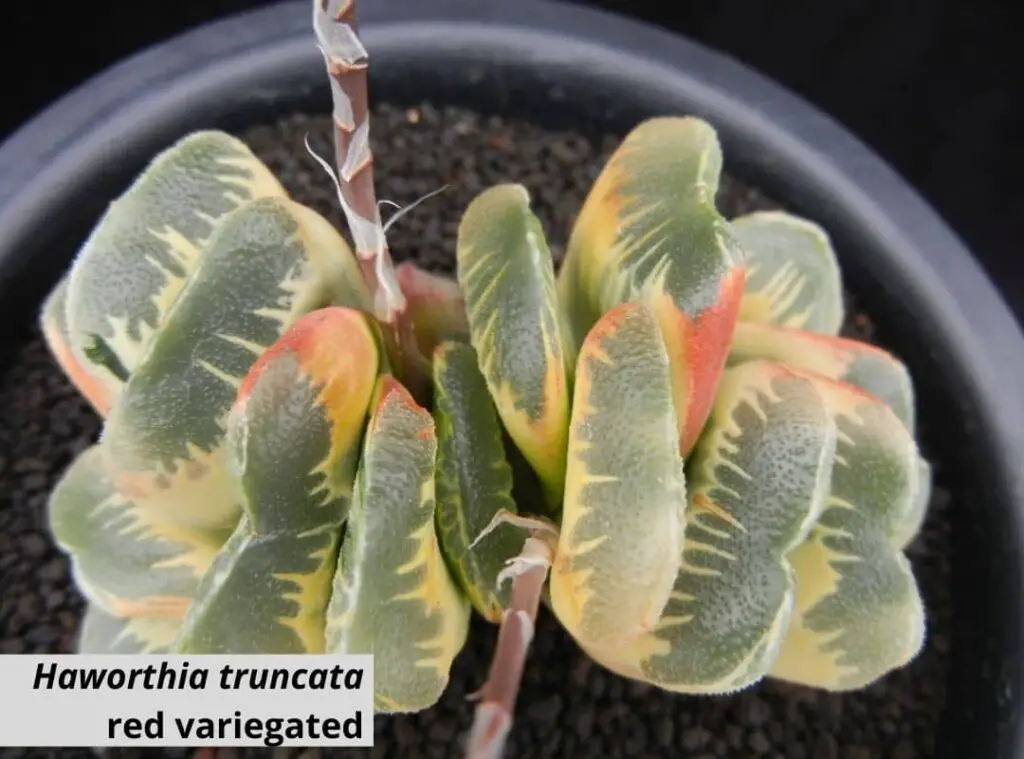
Haworthia truncata ‘red variegated’ is a nursery produced cultivar. They are a stunning stemless set of plants which have their own uniqueness.
Their leaves would carry windows on the upper tips. You could spot them growing either solitary or in clumps.
There could be some plants which are not branched and there could be some which form clusters. Their leaves do not form in rosettes.
Instead, you will feel like these plants are arranged sort of like a fan. When the plant grows and mature, they would tend to take an almost crested appearance.
These are native plants in South Africa. Red variegated plants would prefer to grow in 10a – 11b hardiness zones.
They could be about 0.8 inches tall and would be about 4 inches wide. They would perfectly fit in as indoor plants or outdoor plants.
However, you need to make sure that you provide all the right growing conditions, so that they can thrive well.
Lithops karasmontana ‘Orange Ice’
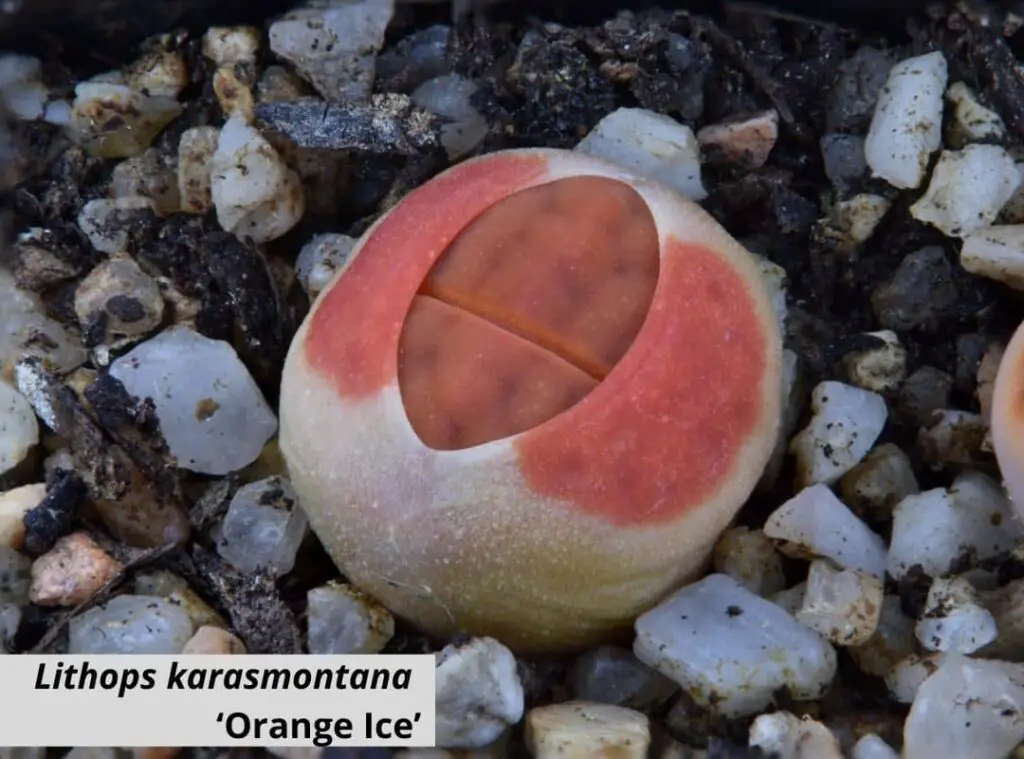
Lithops karasmontana ‘Orange Ice’ is a small succulent. It is as small as two inches when it is grown to its fullest potential.
Having said that, orange ice plants would tend to grow in densely made clumps. They would produce more offsets.
You could spot their leaves form in pairs. They are chunky and carry a leaf center in orange. You could expect them to flower with white blooms during Autumn.
Orange ice is a slow growing plant and native plant in South Africa and in Namibia. Their preferred USDA hardiness zone is 10. You could grow them as indoor plants as well as outdoors.
Mammillaria elongata cristata ‘Copper King’
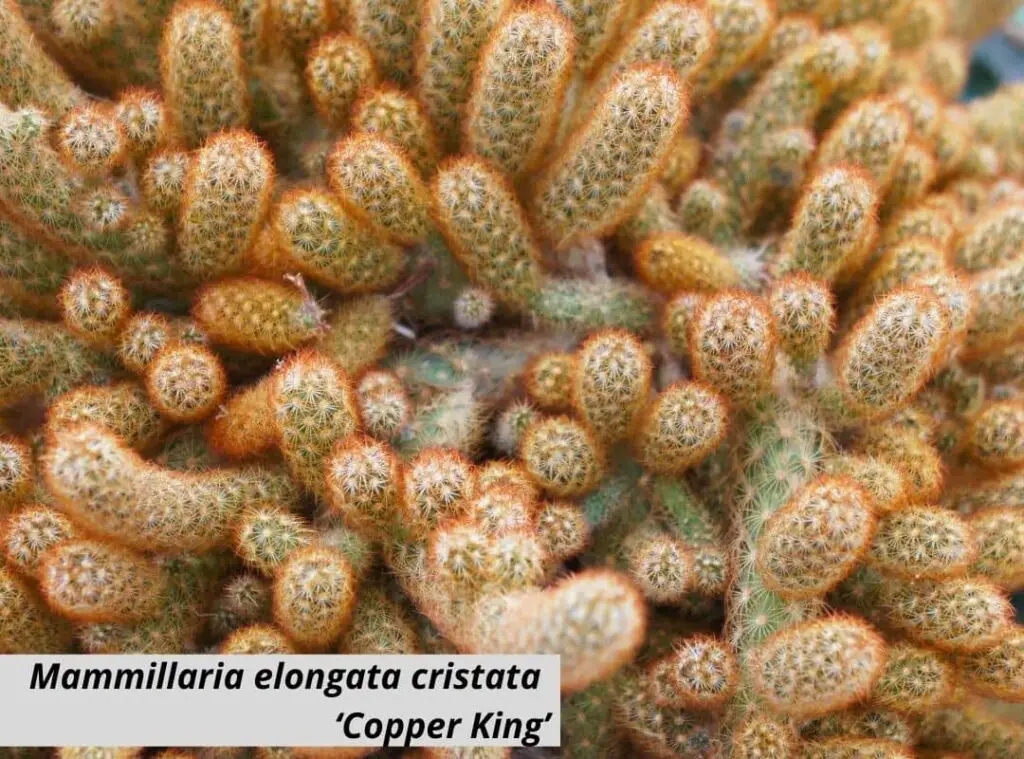
Mammillaria elongata cristata ‘Copper King’ are endemic plants to central Mexico. They usually form in densely made tight clumps.
They would be quite handy to use as ground covers. Having said that, they are not fast growers either. They consist of stems in bright green.
They could be about 8 inches in height. These plants would further consist with coppery orange spines as well. That is why they have inherited this name.
They will start to bloom with pale yellow or white colored blooms during spring. The plant itself tends to grow in a cylindrical shape.
They are suitable for both indoor gardening and for outdoor gardening as well. No matter where you place them, you need to be vigilant on their right growing conditions and act accordingly.
Their preferred USDA hardiness zones are 10-11.
Opuntia rufida minima ‘Mini Cinnamon Cactus’
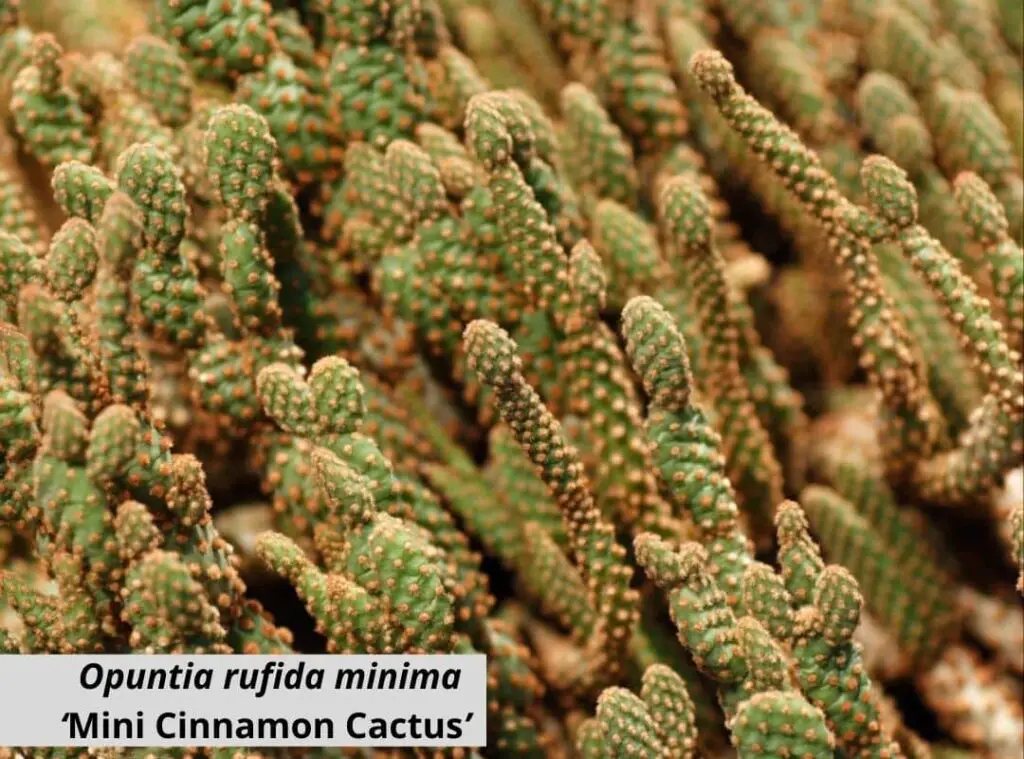
Opuntia rufida minima ‘Mini Cinnamon Cactus’ would be about 10 inches in height. Further they are native plants in the United States.
They have got brown, orange spines covering the pads. You could expect mini cinnamon cacti to flower in spring.
They would be carrying various shades in yellow. You could grow mini cinnamon cactus indoors as well as outdoors. However, ensure that you protect them from colder weather conditions though.
This is a petite paddle cactus which will have dots of cinnamon colored glochids. Further chances are that they will form in fuzzy spike clusters through the pads as well.
Their preferred USDA growth zones are 9a-11b.
Orange Aloe vera
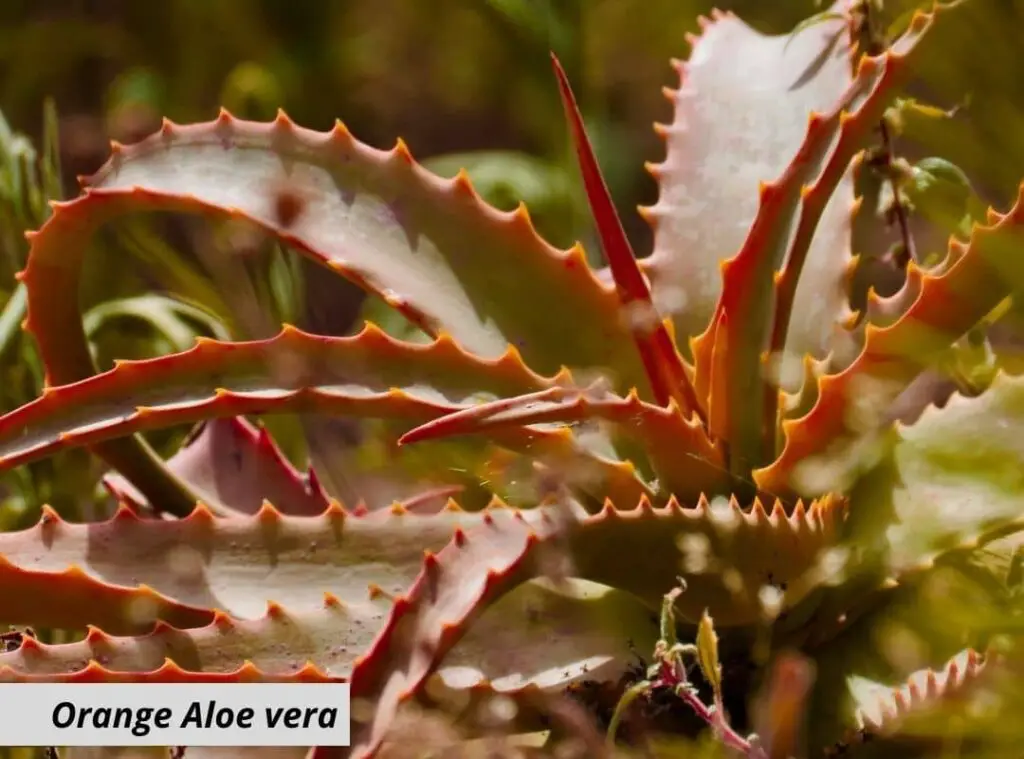
Orange Aloe vera are native plants in South Africa. They consist of spine leaves which form a rosette type.
In terms of flowering, Aloe Vera produces flowers in orange or red. Further they would be tubular shaped.
Orange Aloe vera would prefer to grow in USDA hardiness zones 9-11. They are quite used for arid conditions.
As such you need to protect them from cooler weather conditions when you are growing them outdoors.
These plants would suit both outdoors and indoor gardening. They would grow up to about 5 feet in height and 2-3 feet in width.
Related Question
Are colored succulents real?
Colored succulents are real. If you expose them for bright sunlight, succulents will become vibrant in colors and they will form in different colors such as red, orange, pink, purple, and in yellow.
What colors can succulents be?
You could spot succulents in red, orange, pink, purple and yellow. Succulents could be usually spotted in green.
However, they could be visible in the aforesaid colors once they expose for bright sunlight. To elaborate further, you may spot succulents in vibrant red, muted blue colors and so many other colors mentioned aforesaid.
Succulents could be very handy to add a wide array of colors for your garden collection.
Conclusion
You could always go with a garden full of ordinary green colored succulents, but wouldn’t that be nice to add a little vibrant color to your garden.
Orange succulents would perfectly suit your requirement and I hope now you are aware of what sort of orange succulents you would want to have.
You could select an orange succulents depending on your wish. You could select an orange succulents from pastel peach to sunset color etc.
So, why wait, hurry up, grab your orange succulents and start growing!
Read Next: Red succulents | 27 Unique Red Succulents For Your Garden |
